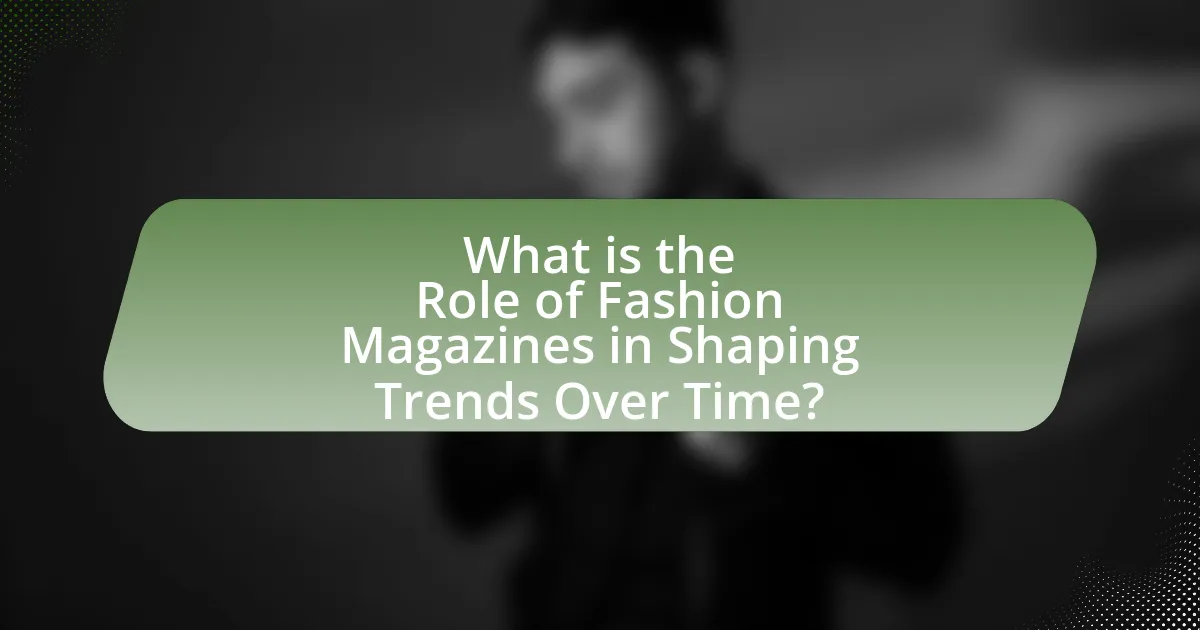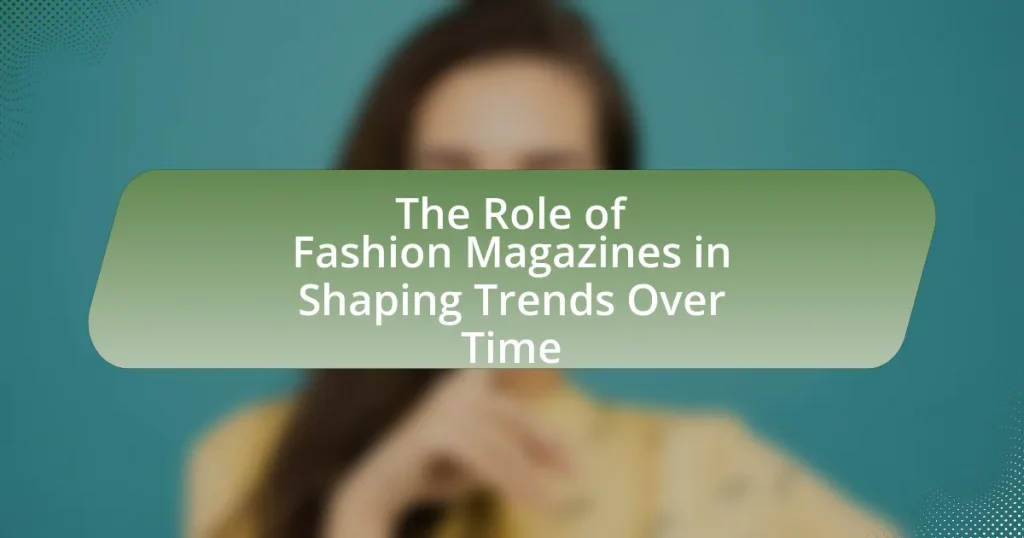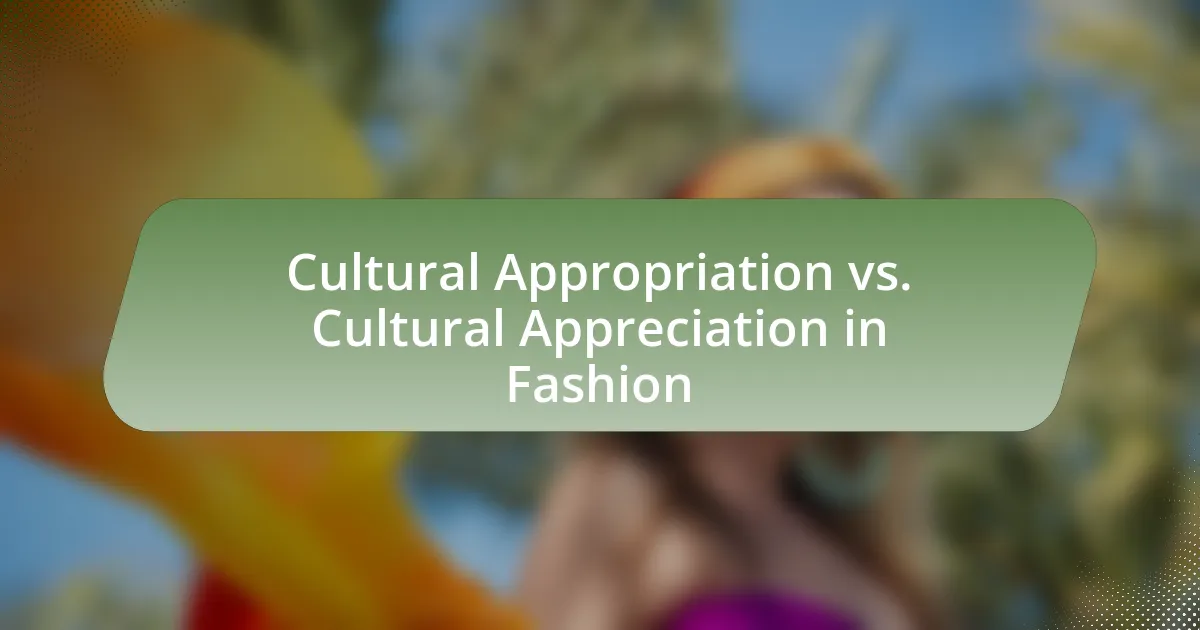Fashion magazines are pivotal in shaping trends over time, acting as influential platforms that showcase styles, designers, and cultural movements. They curate content that highlights emerging fashion trends, impacting consumer behavior and retail strategies through editorials and advertisements. Historical events, such as World War I and the feminist movement, have significantly influenced the content and representation within these magazines, reflecting societal changes in beauty standards. Additionally, the rise of digital platforms and social media has transformed readership and engagement, prompting magazines to focus on sustainability and inclusivity in their content. This article explores the multifaceted role of fashion magazines in trendsetting, their interaction with designers, and the innovations shaping their future.

What is the Role of Fashion Magazines in Shaping Trends Over Time?
Fashion magazines play a crucial role in shaping trends over time by serving as influential platforms for showcasing styles, designers, and cultural movements. They curate content that highlights emerging fashion trends, often dictating what is considered fashionable through editorials, advertisements, and features on designers. For instance, the rise of streetwear in the late 2010s was significantly propelled by magazines like Vogue and GQ, which featured these styles prominently, thus legitimizing them within mainstream fashion. Additionally, fashion magazines often set the tone for seasonal trends through their fashion weeks coverage and trend forecasting, impacting consumer behavior and retail strategies. This influence is supported by the fact that fashion magazines have historically been at the forefront of introducing new designers and styles, shaping public perception and acceptance of various fashion movements.
How have fashion magazines influenced public perception of style?
Fashion magazines have significantly influenced public perception of style by establishing trends and shaping consumer preferences. Through curated visuals, editorials, and articles, these publications present specific styles as desirable, often dictating what is considered fashionable. For instance, the rise of supermodels in the 1990s, prominently featured in magazines like Vogue and Harper’s Bazaar, created a standard of beauty and style that many aspired to emulate. Additionally, studies have shown that exposure to fashion magazine content correlates with increased consumer spending on fashion items, highlighting their role in shaping not just perceptions but also purchasing behavior.
What historical events have shaped the content of fashion magazines?
The content of fashion magazines has been significantly shaped by historical events such as World War I, the Great Depression, and the rise of the feminist movement. World War I led to a shift in women’s roles, resulting in magazines promoting practical fashion that reflected women’s increased participation in the workforce. The Great Depression caused a focus on affordability and practicality in fashion, with magazines emphasizing budget-friendly styles. The feminist movement of the 1960s and 1970s brought attention to women’s empowerment, leading fashion magazines to feature diverse representations of women and challenge traditional beauty standards. These events collectively influenced the editorial direction and cultural relevance of fashion magazines throughout history.
How do fashion magazines reflect societal changes in beauty standards?
Fashion magazines reflect societal changes in beauty standards by showcasing evolving ideals of attractiveness and diversity in their content. For instance, the shift from predominantly thin, Eurocentric models in the 1990s to a more inclusive representation of body types, ethnicities, and ages in recent years illustrates this change. Research by the American Psychological Association indicates that exposure to diverse beauty representations in media can positively influence self-esteem and body image among readers. Additionally, campaigns like Dove’s “Real Beauty” have been featured in fashion magazines, promoting body positivity and challenging traditional beauty norms, further evidencing the magazines’ role in mirroring and shaping societal perceptions of beauty.
Why are fashion magazines considered trendsetters?
Fashion magazines are considered trendsetters because they have the power to influence consumer behavior and shape public perceptions of style. These publications curate and showcase emerging designers, styles, and cultural movements, often setting the agenda for what is deemed fashionable. For instance, the September issue of Vogue, often referred to as the “fashion bible,” has historically launched trends that dominate the fashion landscape, as seen with the rise of streetwear in the late 2010s, which was heavily featured in various fashion magazines before gaining mainstream acceptance. This ability to highlight and promote new ideas solidifies their role as key players in the fashion industry, making them pivotal in determining trends.
What mechanisms do fashion magazines use to introduce new trends?
Fashion magazines introduce new trends primarily through editorial content, visual storytelling, and influencer collaborations. Editorial content, such as trend reports and style guides, provides readers with insights into emerging styles, often backed by expert opinions and fashion forecasts. Visual storytelling, including high-quality photography and fashion spreads, showcases these trends in an aspirational context, making them appealing to consumers. Collaborations with influencers and designers further amplify these trends, as magazines leverage their reach to create buzz and drive consumer interest. For instance, the September issue of Vogue often sets the tone for the upcoming fashion season, highlighting key trends that are expected to dominate the market.
How do collaborations with designers impact trendsetting?
Collaborations with designers significantly impact trendsetting by merging unique creative visions, which often leads to innovative products that capture consumer interest. These partnerships can generate buzz and excitement, as seen in high-profile collaborations like H&M with designers such as Karl Lagerfeld, which resulted in sold-out collections and heightened brand visibility. Such collaborations often leverage the designer’s established reputation and the retailer’s market reach, creating a powerful synergy that influences consumer behavior and sets new trends in the fashion industry.
What role do fashion magazines play in the fashion industry ecosystem?
Fashion magazines serve as critical influencers in the fashion industry ecosystem by shaping trends, providing a platform for designers, and guiding consumer preferences. They curate and disseminate fashion content that highlights emerging styles, thereby impacting what consumers perceive as fashionable. For instance, magazines like Vogue and Harper’s Bazaar have historically set trends by featuring specific designers and styles, which can lead to increased visibility and sales for those brands. Additionally, fashion magazines often collaborate with designers for exclusive collections or features, further solidifying their role as trendsetters. Their editorial choices can significantly affect market dynamics, as seen in the rise of sustainable fashion, which gained traction through consistent coverage in leading publications.
How do fashion magazines interact with designers and brands?
Fashion magazines interact with designers and brands primarily through editorial features, advertising partnerships, and event coverage. These publications showcase designers’ collections, often influencing public perception and trends by highlighting specific styles or products. For instance, magazines like Vogue and Harper’s Bazaar frequently collaborate with designers for exclusive photo shoots, which can significantly boost a brand’s visibility and desirability. Additionally, fashion magazines often attend and report on fashion shows, providing critical exposure that can lead to increased sales and brand recognition. This interaction is supported by the fact that a feature in a prominent fashion magazine can lead to a measurable increase in consumer interest and sales, as evidenced by studies showing that magazine placements can drive traffic to designers’ websites and retail outlets.
What is the significance of editorial choices in trend development?
Editorial choices are significant in trend development as they determine which styles, designers, and cultural narratives receive visibility and validation within the fashion industry. These choices influence consumer perceptions and behaviors, shaping what is considered fashionable or desirable. For instance, fashion magazines like Vogue and Harper’s Bazaar have historically played pivotal roles in introducing and popularizing trends through curated editorial content, photoshoots, and features on emerging designers. This editorial influence is evidenced by the rise of specific trends, such as the prominence of streetwear in the late 2010s, which was propelled by strategic editorial coverage that highlighted its cultural relevance and appeal.
How have digital transformations affected fashion magazines?
Digital transformations have significantly altered fashion magazines by shifting their focus from print to digital platforms, enhancing accessibility and interactivity. This transition has allowed fashion magazines to reach a broader audience through online content, social media engagement, and multimedia storytelling, which traditional print formats could not achieve. For instance, Vogue’s digital presence has expanded its readership, with over 30 million unique visitors monthly, showcasing the effectiveness of digital strategies in attracting audiences. Additionally, the integration of e-commerce features within digital magazines has enabled direct shopping experiences, further influencing consumer behavior and trend adoption.
What changes have occurred in readership and engagement due to online platforms?
Online platforms have significantly transformed readership and engagement by increasing accessibility and interactivity. Traditional fashion magazines have seen a decline in print readership, with a 20% drop in circulation reported from 2017 to 2021, as consumers shift to digital formats. This transition has led to enhanced engagement through social media, where fashion brands and magazines can interact directly with audiences, resulting in a 50% increase in user-generated content related to fashion trends. Additionally, online platforms enable real-time feedback and analytics, allowing publishers to tailor content to audience preferences, thus fostering a more personalized reading experience.
How do social media and influencers complement traditional fashion magazines?
Social media and influencers complement traditional fashion magazines by providing immediate access to trends and fostering direct engagement with audiences. While fashion magazines curate content and offer in-depth analysis, social media platforms allow influencers to showcase styles in real-time, creating a dynamic dialogue with followers. According to a 2021 study by the Fashion Institute of Technology, 70% of consumers reported that they trust influencers more than traditional advertising, highlighting the effectiveness of influencer marketing in shaping consumer perceptions. This synergy enhances the reach and relevance of fashion magazines, as they can leverage influencer partnerships to attract younger demographics who primarily consume content online.
What are the future trends for fashion magazines in shaping style?
Future trends for fashion magazines in shaping style include a greater emphasis on digital content, sustainability, and inclusivity. As print circulation declines, fashion magazines are increasingly focusing on online platforms to reach wider audiences, utilizing social media and interactive content to engage readers. Additionally, there is a rising demand for sustainable fashion, prompting magazines to highlight eco-friendly brands and practices, reflecting consumer values. Furthermore, inclusivity in representation is becoming a priority, with magazines showcasing diverse models and styles that cater to a broader demographic, thereby influencing contemporary fashion norms. These trends are supported by industry reports indicating that digital engagement and sustainability are key factors driving consumer interest in fashion.
How might sustainability influence the content of fashion magazines?
Sustainability significantly influences the content of fashion magazines by prioritizing eco-friendly practices and ethical fashion choices. This shift leads to increased coverage of sustainable brands, materials, and production methods, reflecting a growing consumer demand for environmentally responsible fashion. For instance, a report by McKinsey & Company indicates that 67% of consumers consider sustainability when making a purchase, prompting magazines to feature articles that educate readers on sustainable practices and highlight brands committed to reducing their environmental impact. Consequently, fashion magazines are evolving to include sustainability as a core theme, shaping industry trends and consumer behavior.
What innovations are emerging in the fashion magazine industry?
Innovations emerging in the fashion magazine industry include the integration of augmented reality (AR) and virtual reality (VR) technologies, which enhance reader engagement by allowing interactive experiences with fashion content. For instance, publications like Vogue have begun using AR features in their digital editions, enabling readers to visualize clothing items in 3D or try on virtual outfits. Additionally, the rise of data analytics is transforming how magazines curate content, as they leverage reader preferences and behaviors to tailor articles and advertisements, thereby increasing relevance and engagement. According to a report by McKinsey & Company, the use of data-driven strategies in media has shown to improve audience retention rates significantly, indicating a shift towards more personalized fashion journalism.
What practical tips can readers apply from fashion magazines to their personal style?
Readers can apply several practical tips from fashion magazines to enhance their personal style, such as experimenting with layering, incorporating statement accessories, and understanding color theory. Fashion magazines often showcase layering techniques that add depth and interest to outfits, encouraging readers to mix textures and lengths for a more dynamic look. Additionally, the use of statement accessories, highlighted in various editorial spreads, can transform a simple outfit into a standout ensemble, emphasizing the importance of bold pieces like oversized jewelry or unique handbags. Understanding color theory, as discussed in articles, helps readers choose complementary colors that enhance their overall appearance, making their outfits more visually appealing. These tips are grounded in the editorial practices of fashion magazines, which aim to inspire readers to develop a distinctive and confident personal style.




